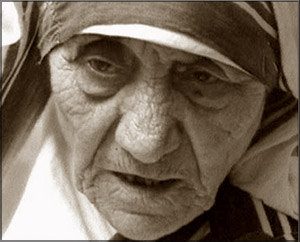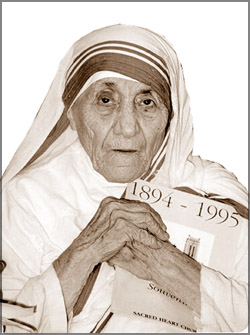Agnes Gonxha Bojaxhiu
For over forty years, she ministered to the needs of
the poor, sick, orphaned, and dying of Calcutta (Kolkata)
Mother Teresa, born Agnes Gonxha
Bojaxhiu IPA:(August 26, 1910 " September 5, 1997), was an Albanian
Roman Catholic nun who founded the Missionaries of Charity and won the
Nobel Peace Prize in1979 for her humanitarian work.
For over forty years, she ministered to the needs of the poor, sick,
orphaned, and dying of Calcutta (Kolkata). As herreligious order grew
she expanded her ministry to other countries. By the 1970s she had
become internationally famed as a humanitarian andadvocate for the poor
and helpless, due in part to a documentary, and book, Something
Beautiful for God by Malcolm Muggeridge.
A famed left-leaning journalist, he credited her with inspiring his
conversion to Catholic ismlate in life. Following her death she was beatified by Pope John Paul II and designated Blessed
Teresa of Calcutta.[1][2] However, she and the order she founded have
attracted criticism in latter years with respect to care of the sick and
destination of financial contributions.
her death she was beatified by Pope John Paul II and designated Blessed
Teresa of Calcutta.[1][2] However, she and the order she founded have
attracted criticism in latter years with respect to care of the sick and
destination of financial contributions.
Biography Mother Teresa was born Agnes Gonxha Bojaxhiu in Skopje*,
Macedonia, on August 27, 1910. Her family was of Albanian descent. At
the age of twelve, she felt strongly the call of God. She knew she had
to be a missionary tospread the love of Christ.
At the age of eighteen she left her parental home in Skopje and
joined the Sisters of Loreto, an Irish community of nuns with missions
in India. After a few months' training in Dublin she was sent to India,
where on May 24, 1931, she took her initial vows as a nun.
From 1931to 1948 Mother Teresa taught at St. Mary's High School in
Calcutta, but the suffering and poverty she glimpsed outside the convent
walls made such a deep impression on her that in 1948 she received
permission from her superiors to leave the convent school and devote
herself to working among the poorest of the poor in the slums of
Calcutta.
Although she had no funds, she depended on Divine Providence, and
started an open-air school for slum children. Soon she was joined by
voluntary helpers, and financial support was also forthcoming.
This made it possible for her to extend the scope ofher work. On
October 7, 1950, Mother Teresa received permission from the Holy See to
start her own order, "The Missionaries of Charity", whose primary task
was to love and care for those persons nobody was prepared to look
after. In1965 the Society became an International Religious Family by a
decree of Pope Paul VI. Today the order comprises Active and
Contemplative branches of Sisters and Brothers in many countries.
In 1963 both the Contemplative branch of the Sisters and the Active
branch of the Brothers was founded. In 1979 the Contemplative branch of
the Brothers was added, and in 1984 the Priest branch was established.
The Society of Missionaries has spread all over the world, including
the former Soviet Union and Eastern European countries. They provide
effective help to the poorest of the poor in a number of countries in
Asia, Africa, and Latin America, and they undertake relief work in the
wake of naturalc atastrophes such as floods, epidemics, and famine, and
for refugees. The order also has houses in North America, Europe and
Australia, where they take care of the shut-ins, alcoholics, homeless,
and AIDS sufferers.
The Missionaries of Charity throughout the world are aided and
assisted by Co-Workers who became an official International Association
on March 29,1969. By the 1990s there were over one million Co-Workers in
more
 than
40countries. Along with the Co-Workers, the lay Missionaries of Charity
try to follow Mother Teresa's spirit and charism in their families. than
40countries. Along with the Co-Workers, the lay Missionaries of Charity
try to follow Mother Teresa's spirit and charism in their families.
Mother Teresa's work has been recognised and acclaimed throughout the
world and she has received a number of awards and distinctions,
including the Pope John XXIII Peace Prize (1971) and the Nehru Prize for
her promotion of international peace and understanding (1972).
She also received the Balzan Prize (1979) and the Templeton and
Magsay say awards. From Nobel Lectures, Peace 1971-1980,
Editor-in-Charge Tore FrAongsmyr, Editor Irwin Abrams, World Scientific
Publishing Co., Singapore, 1997This autobiography/biography was first
published in the book series Les PrixNobel. It was later edited and
republished in Nobel Lectures.
To cite this document, always state the source as shown above. Early
life Agnes Bojaxhiu was born on 26 August,[3] 1910, in the center of
Uskub, inthe Kosovo Province of the Ottoman Empire (now Skopje,
Macedonia).
Herparents were Albanians; her father, Nikoll, was originally from
Mirdita(North Albania) and her mother, Dranafille, came from akovica (Gjakov).Raised
as a Catholic by her parents, her father died when she was about eight
years old.
During her early years, she was fascinated with stories of missionary
life and service. By the time she was twelve, Agnes was convinced that
her vocation should be a religious life.[5]She left her homeat age 18 to
join the Sisters of Loreto as a missionary.
Agnes would never again set eyes on her mother or sister.[6]She
initially went to the Loreto Abbey in Rathfarnham, Ireland in order to
learn English, which was the language nuns used to instruct India's
school children. Arriving in India in 1929, she began her novitiate in
Darjeeling, near the Himalayas.
She took her first vows as a nun on 24May 1931, choosing the name
Teresa after the patron saint of missionaries. She took her solemn vows
on 14 May 1937 while serving as a teacher at the Loreto convent school
in eastern Calcutta. Although Teresa enjoyed teaching at the school she
was increasingly disturbed by the poverty surrounding her in Calcutta.
A famine in 1943 brought misery and death to the city; the outbreak
of Hindu/Muslim violence in August 1946 plunged the city into despair
and horror.
The Missionaries of Charity On September 10, 1946, Teresa experienced
what she later described as "the call within the call" while travelling
to the Loreto convent in Darjeeling for her annual retreat. "I was to
leave the convent and help the poor whileliving among them.
It was an order. To fail would have been to break the faith." She
began her missionary work with the poor in 1948, replacing her long,
traditional Loreto habit with a simple white cotton sari decorated with
a blue border and then venturing out into the slums."
Initially she started a school in Motijhil; shortly thereafter, she
started tending to the needs of the destitute and starving. Her efforts
quickly caught the attention of Indian officials, including the Prime
Minister, who expressed his appreciation. Teresa's first year was
fraught with difficulties. She had no income and had to resort to
begging for food and supplies.
Teresa experienced doubt, loneliness and the temptation to return to
the comfort of convent life during these early months. She recorded in
her diary:" Our Lord wants me to be a free nun covered with the poverty
of the cross. Today I learned a good lesson.
The poverty of the poor must be so hard for them. While looking for a
home I walked and walked till my arms and legs ached. I thought how much
they must ache in body and soul, looking for a home, food and health.
Then the comfort of Loreto [her former order] came to tempt me. 'You
have only to say the word and all that will be yours again, 'the Tempter
kept on saying ... Of free choice, my God, and out of love for you, I
desire to remain and do whatever be your Holy will in my regard. I did
not let a single tear come. "Mother Teresa's Home for the Dying in
Kolkata (Calcutta).Teresa received Vatican permission on October 7, 1950
to start the diocesan congregation that would become the Missionaries of
Charity.
Its mission was to care for, in her own words, "the hungry, the
naked, the homeless, the crippled, the blind, the lepers, all those
people who feel unwanted, unloved, uncared for throughout society,
people that have become a burden to the society and are shunned by
everyone."
In 1952 Mother Teresa opened the first Home for the Dying in space
made available by the City of Calcutta. With the help of Indian
officials she converted an abandoned Hindu temple into the Kalighat Home
for the Dying, a free hospice for the poor. She renamed it Kalighat, the
Home of the Pure Heart (Nirmal Hriday).
Those brought to the home received medical attention and were
afforded the opportunity to die with dignity, according to the rituals
of their faith; Muslims were read the Quoran, Hindus received water from
the Ganges, and Catholics received the Last Rites. "A beautiful death,"
she said "is for people who lived like animals to die like angels "
loved and wanted.
"She soon opened a home for those suffering from Hansen's disease,
commonly known as leprosy, and called the hospice Shanti Nagar (City of
Peace).
The Missionaries of Charity also established several leprosy out
reach clinics throughout Calcutta, providing medication, bandages and
food. As the Missionaries of Charity took in increasing numbers of lost
children, Mother Teresa felt the need to create a home for them. In 1955
she opened the Nirmala Shishu Bhavan, the Children's Home of the
Immaculate Heart, as a haven for orphans and homeless youth.
The order soon began to attract both recruits and charitable
donations, and by the 1960s had opened hospices, orphanages, and leper
houses all over India. She was one of the first to establish homes for
AIDS victims. Mother Teresa's order started to grow rapidly, with new
homes opening throughout the globe. The order's first house outside
India was in Venezuela, opened in 1965 with five sisters.
Others followed in Rome,Tanzania, and Austria in 1968; during the
1970s the order would open housesand foundations in dozens of countries
in Asia, Africa, Europe, and theUnited States. |
